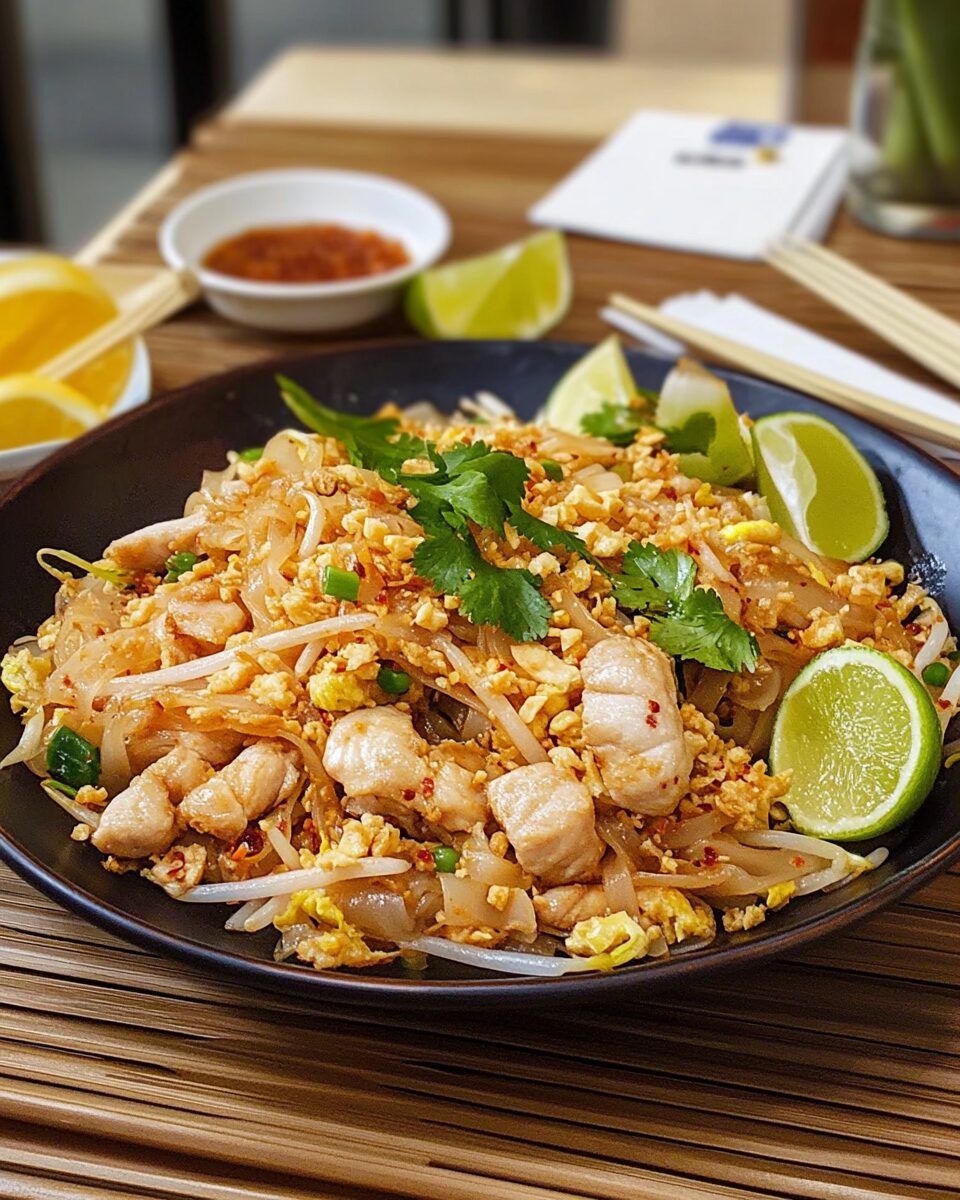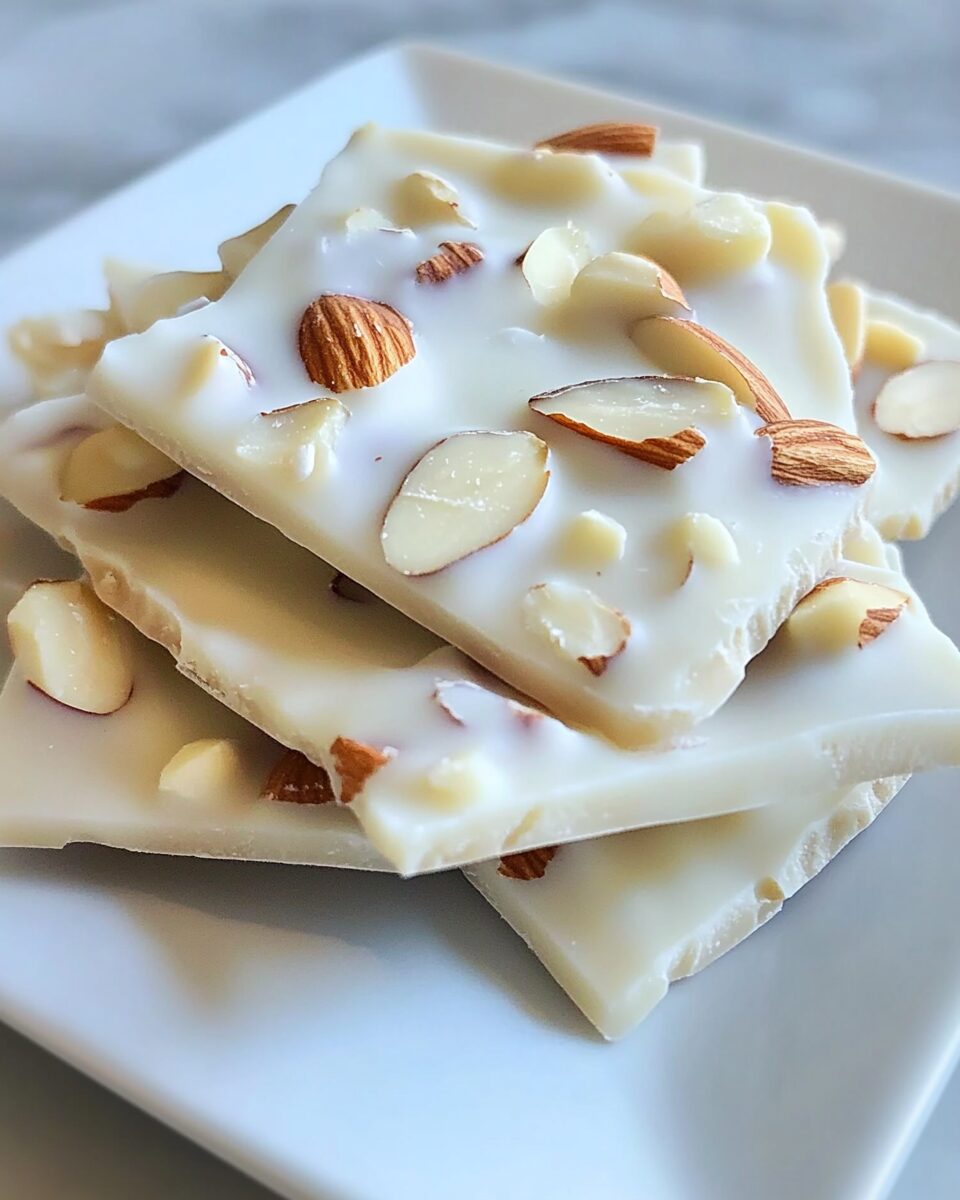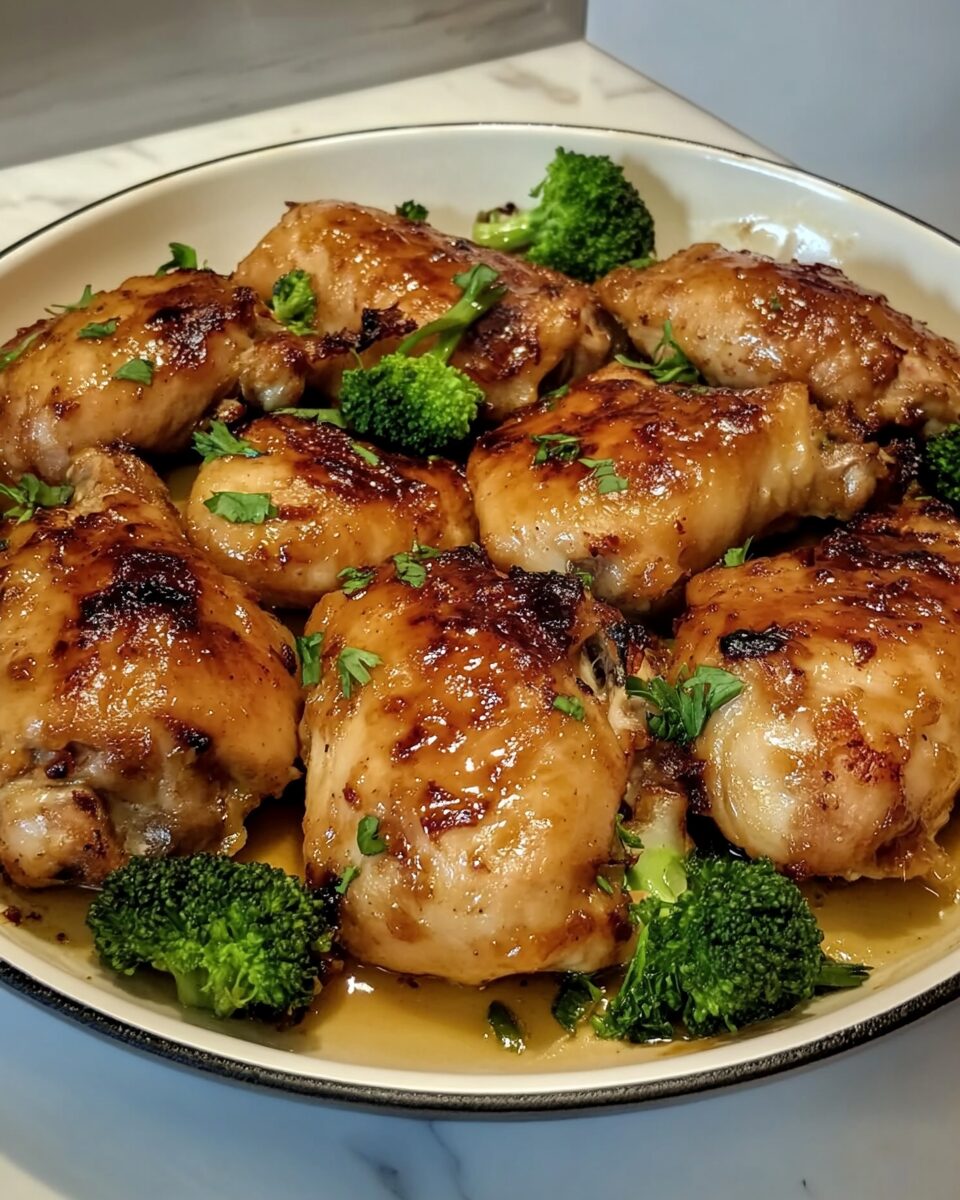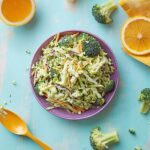Pad Thai is a staple of Thai cuisine, combining a delicious balance of flavors and textures in one dish. The slightly chewy rice noodles are stir-fried with plump shrimp, peanuts, and bean sprouts, all brought together by a tangy, sweet-savory sauce made with tamarind and fish sauce. A squeeze of fresh lime adds brightness that enhances every bite. This dish is both comforting and refreshing, perfect for a quick weeknight dinner or a fun weekend cooking project. Not only is it easy to make, but it’s also customizable to suit your taste – feel free to adjust the spice level or swap the shrimp for chicken or tofu. Whether you’re a fan of Thai food or just looking for something new to try, this Pad Thai will hit the spot!
Full recipe:
Ingredients:
- 8 oz dried rice noodles
- 2 tablespoons vegetable oil
- 1 pound shrimp, peeled and deveined
- 2 eggs, lightly beaten
- 1/4 cup fish sauce
- 2 tablespoons tamarind paste
- 1 tablespoon sugar
- 1 teaspoon chili powder (optional)
- 1/4 cup peanuts, chopped
- 1/4 cup green onions, chopped
- 1/4 cup bean sprouts
- 1 lime, cut into wedges
Directions:
- Cook the rice noodles according to package instructions, drain, and set aside.
- Heat oil in a large skillet over medium heat. Add shrimp and cook for 3-4 minutes until pink and cooked through. Remove and set aside.
- Add eggs to the skillet and scramble until cooked, about 1-2 minutes.
- Stir in fish sauce, tamarind paste, sugar, and chili powder. Cook for another 2 minutes until the sauce thickens slightly.
- Add the cooked noodles and shrimp back into the skillet and toss to combine everything.
- Stir in peanuts, green onions, and bean sprouts. Remove from heat.
- Serve with lime wedges on the side for squeezing over the dish.
Prep Time: 10 minutes | Cooking Time: 15 minutes | Total Time: 25 minutes
Kcal: 380 kcal | Servings: 4 servings
What Makes This Pad Thai Special
This version of Pad Thai stands out for its authentic approach and well-rounded flavor profile. Shrimp is a traditional protein choice for Pad Thai, adding a subtle sweetness that contrasts perfectly with the tangy tamarind and the richness of peanuts. The fish sauce gives it a distinct umami depth, while the tamarind paste provides a gentle sourness that enhances the dish’s overall complexity. Fresh ingredients like bean sprouts, green onions, and lime not only add a refreshing crunch but also a boost of vitamins and antioxidants.
1. Health Benefits: Pad Thai is packed with beneficial ingredients that promote health and well-being. Shrimp, for instance, is an excellent source of lean protein, low in calories, and rich in omega-3 fatty acids, which are known to support heart health and brain function. The peanuts in this recipe offer a good dose of healthy fats, plant-based protein, and essential minerals such as magnesium and phosphorus. Additionally, bean sprouts and green onions provide fiber and essential vitamins like vitamin C and K, boosting immunity and supporting bone health.
2. Nutritional Balance: One of the reasons why Pad Thai is such a beloved dish is because it’s incredibly well-balanced. It offers a mix of proteins, carbs, and fats in each serving, ensuring that you feel satisfied after eating. The rice noodles serve as a good source of carbohydrates for energy, while the shrimp provides the protein necessary for muscle repair and growth. The peanuts and egg add healthy fats that help maintain optimal brain function and cell health.
3. Customization for Dietary Needs: This recipe is also highly versatile, making it suitable for various dietary preferences. If you’re vegetarian or vegan, you can easily substitute the shrimp with tofu and replace the fish sauce with soy sauce or tamari for a plant-based option. For those on a gluten-free diet, this Pad Thai recipe is naturally gluten-free, as it uses rice noodles instead of wheat-based ones, making it a great option for those with gluten sensitivities or celiac disease.
Why This Pad Thai Recipe is the Best
This Pad Thai recipe excels for several reasons. First, it stays true to the classic Thai street food experience by using traditional ingredients such as tamarind paste, fish sauce, and peanuts. These ingredients are essential in achieving the authentic taste that sets Pad Thai apart from other stir-fried noodle dishes. Many versions of Pad Thai sold internationally rely on ketchup or sugar-heavy sauces to replicate the tangy-sweet flavor, but this recipe sticks to the original balance of tamarind and fish sauce, ensuring that the dish is not overly sweet but rather perfectly balanced.
Another standout feature is the quick preparation time. This recipe only takes about 25 minutes from start to finish, making it an excellent option for busy weeknights. The use of simple, fresh ingredients also means you can whip up this delicious meal without needing to rely on pre-packaged sauces or artificial flavors. It’s a dish that’s easy to make yet bursting with authentic flavor, perfect for both beginner cooks and experienced food enthusiasts.
Tips for Perfecting Your Pad Thai
- Noodle Preparation: One of the most critical steps in making Pad Thai is ensuring your rice noodles are cooked to the right texture. Overcooking them can make them mushy, while undercooking leaves them too firm. Follow the package instructions carefully, and if needed, rinse the noodles in cold water after boiling to stop the cooking process. This helps prevent them from clumping together when stir-frying.
- Tamarind Sauce: If you can’t find tamarind paste, you can make your own by soaking tamarind pulp in warm water and straining it to get the juice. This ingredient is key to achieving the signature tangy flavor of Pad Thai, so it’s worth seeking out at your local Asian market or online.
- Personalize the Heat: While the recipe calls for a teaspoon of chili powder, you can adjust this according to your heat preference. If you like it spicy, feel free to add more chili powder or top your finished dish with fresh chopped chilies. If you prefer a milder dish, reduce or omit the chili altogether.
- Lime Juice Adds Magic: Don’t skip the fresh lime wedges served on the side. Lime juice brings out the vibrant flavors in the dish, especially when squeezed over just before eating. It adds a bright, zesty note that cuts through the richness of the sauce and shrimp.
- Make It a Complete Meal: To turn your Pad Thai into a complete, restaurant-quality meal, consider serving it with a light Thai-style salad or a side of steamed vegetables. You can also pair it with a cold Thai iced tea or a refreshing coconut water drink for a true taste of Thailand.
Serving Suggestions and Variations
While this shrimp-based Pad Thai is delicious as-is, there are several ways to switch things up and make the dish your own. Here are a few ideas:
- Chicken or Tofu Pad Thai: Swap the shrimp for chicken breast or firm tofu for a different but equally tasty variation. Both work well with the tangy tamarind sauce and will absorb the flavors beautifully during cooking.
- Extra Veggies: Amp up the nutrition by adding more vegetables like carrots, bell peppers, or snap peas. These will add extra crunch and vibrant color to the dish, making it even more visually appealing.
- Peanut Butter Pad Thai: For a creamier texture, some people enjoy adding a spoonful of peanut butter into the sauce, giving it a richer, nuttier flavor.
Why You Should Try Pad Thai at Home
Making Pad Thai at home is not only fun but also rewarding. Unlike takeout versions, homemade Pad Thai allows you to control the quality of the ingredients and the nutritional content of the dish. You can make it as healthy or indulgent as you like. Plus, cooking Pad Thai at home allows you to experience the fresh, bold flavors of Thailand in your own kitchen without having to travel. It’s a great way to introduce yourself to Thai cuisine if you’re unfamiliar with it, or to enjoy a beloved favorite with your personal twist.
Conclusion
Pad Thai is also a crowd-pleaser. Whether you’re cooking for yourself, family, or friends, this dish is sure to impress with its vibrant colors, complex flavors, and satisfying texture. It’s a dish that transcends cultural borders and brings the essence of Thailand to your table.








